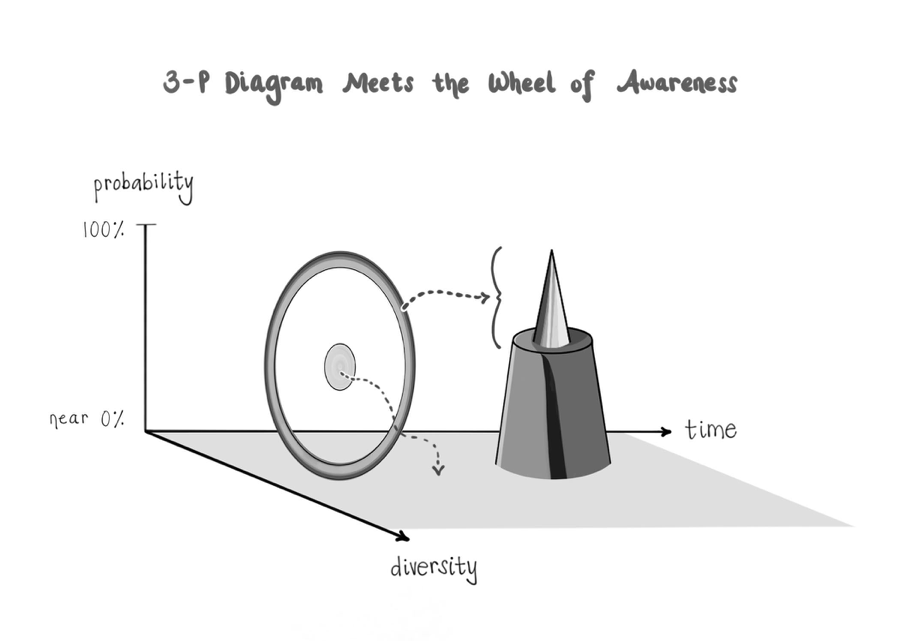Illustrations by my daughter, Madeleine Siegel
Science illuminates the ways in which cultivating the capacity to be aware enhances our health and relationships with one another. I’d like to invite you to reflect on a number of foundational concepts and empirical findings from research that reveal how the ways we develop three aspects of our mental lives—attention, intention, and awareness—actually change the components of our physical health. I summarize these findings in my book, “Aware: The Science and Practice of Presence.”
Studies conducted by a number of researchers over the last two decades have shown that there are three “pillars of mind training” to engage in mental exercises, sometimes called reflective practice, meditation, or mindful awareness practices (MAPs) that include learning to focus attention, open awareness, and generate kind intention.

In the field of interpersonal neurobiology, we view the mind as an emergent property of energy and information flow. When we train the mental process of attention, for example, we learn to strengthen how to direct the flow of energy and information. Much like a light focusing on a particular aspect of our experience, this ability illuminates and stabilizes what is being perceived so that we sense with more focus, depth, and detail.

You might imagine that this ability to focus attention, our first pillar, would be a starting place for how to strengthen the mind itself. As a regulating process, the mind can have two functions—monitoring and modifying—both of which can be strengthened.
Mind training essentially teaches us how to stabilize monitoring and then learn to modify energy and information flow toward something we can simply call integration. Integration is the linking of differentiated element of a system, like the two sides of the brain, or two people in a relationship. A long line of scientific reasoning suggests that integration is the basis of well-being and health. When we honor differences and promote compassionate connecting linkages, we are promoting integration.
Meditation practices that have the three pillars of learning to focus attention, open awareness, and cultivate kind intention teach us how to strengthen monitoring and modifying and, in this fundamental way, strengthen our lives. In the brain, studies reveal that neural integration is enhanced. In our relationships, compassion and empathy are cultivated. These mind-training practices appear to cultivate integration inside and out.
A simple example of one practice that engages all three pillars is a meditation practice I developed years ago called the Wheel of Awareness, which was created with two simple notions in mind: 1) Integration is the basis of well-being; and 2) Consciousness is needed for change.
Then the question naturally arises, can we “integrate consciousness?” I would bring my patients around a table in my office that has a central glass area surrounded by a wooden outer rim, and we’d imagine that the hub of this “wheel” as where we could place the knowing of being aware; on the rim we’d place the knowns of consciousness—that which we are aware of.
To integrate consciousness, we’d systematically move a singular spoke of attention from the hub of knowing to the rim of the knowns. With this simple process, anxiety and mild to moderate depression would be reduced, and certain issues related to unresolved trauma would be more readily resolved.

Over time, this improvement with my patients’ chaos or rigidity in their lives would be sustained, especially if they practiced the Wheel on a regular basis. They seemed to be integrating consciousness and cultivating a sense of harmony in their inner and interpersonal lives. When my students, psychotherapists from many different schools of therapy, would also find this practice helpful for both themselves and for their clients, I felt motivated to then try the Wheel out in workshops around the world, leading to a study of ten thousand individuals.
While every individual is unique, there were common findings across the cultures and professional backgrounds of the individual participants that gave a sense of a universal window into the nature of the mind. I took these results with me as I would wander and wonder about how a proposal from decades ago that the mind might be an emergent property of energy flow. Could the science of energy offer us something that might relate to the reports of the Wheel study?
I was offered the opportunity of spending quite a bit of time with experts in energy, those in the field of physics, and from those discussions I was able to discover some fundamental notions of what energy is. Energy, they would say, is “the movement from possibility to actuality.” That mind-opening view of energy could then be carefully mapped out in a way that would visually illustrate this mathematical notion of a movement across what some would call a “probability distribution curve.”
On the y-axis, this would vertically reveal a span extending between near-zero probability at the bottom, to one hundred percent at the top. In workshops and in my new book, I slowly build this graph so that if this is the first time someone is considering this perspective, it gradually is unpacked and explained, and I’ll simply offer the summary depiction here:

This is called a “3-P” graph as it contains a Peak of activation, such as a thought or memory, a Plateau of raised probability, such as a state of mind or intention, and a Plane of Possibility, which may correlate with pure awareness. In this way, the 3-P graph of a potential mechanism of mind matches with the Wheel of Awareness meditative practice and visual metaphor in this way:

This mapping of mind onto notions of energy arising from a “sea of potential” or “quantum vacuum” that corresponds to this plane of possibility is consistent with quantum physics, though not stated by it. The quantum physicists I have presented this to, including Arthur Zajonc who was the former president of the Mind and Life Institute that studies meditative practices and the brain, are very enthusiastic about what this proposal might help us with in illuminating that nature of mental reality.
Some of the exciting implications of this proposal include the possibilities that the mechanism of being aware, this plane of possibility, is both the source of the knowing of consciousness (how and why, we don’t know) as well as the source of other options in our lives to arise. When we access the plane, when we become aware, we are in a pause that creates a space between impulse and action, and we are also in the “mental space” in which we can find other choices in how to respond in the moment. This is the power of awareness to catalyze choice and change.
These deep dives into the probability nature of energy might help us understand a number of first-person, subjective reports of pure awareness—experienced in the hub-in-hub part of the practice—as having the commonly stated qualities of being: both empty and full; as wide-as-the-sky; peaceful; infinite; love; god; eternal; timeless; joy; and awe. Often there is the initial statement offered that no words can really describe what the “hub feels like.” These repeated responses raise the question of whether the physics’ notion of the plane as the formless “mathematical space” in which all potential forms “rest” might correlate with such subjective descriptions.
It is an exciting time to link this new perspective on an ancient focus of what our minds are, and in particular, what consciousness might be. From the point of view of healthy relationships and healthy mental lives, the metaphor of the hub of the Wheel with its corresponding potential mechanism of the Plane of Possibility, may illuminate the nature of what we can simply call, “presence.” Research reveals that when we have the trait of being present in life, we have well-being in our lives.
How? Presence in relationships means being open to connecting with the differentiated nature of others, creating compassionate and respectful communication while linking yet maintaining a differentiated sense of an inner self. In this important way, integration is more like a fruit salad than a smoothie—we maintain our differentiated nature and link, yet we do not become homogenized.
Benefits of presence
Presence also refers to our inner lives as well, as we are open and receptive to whatever arises. In Wheel terms, we can rest in the hub and essentially say, “bring it on” to whatever might arise from the rim. Research suggests that when we live with such presence, we:
- Optimize our telomerase levels so that we repair and maintain the ends of our chromosomes
- Improve our cardiovascular risk factors
- Reduce inflammation by altering epigenetic regulation of the inflammatory response
- Reduce the stress response
- Enhance our immune function
- Cultivate more integration in the brain yielding more functional regulation of such processes as emotion, attention, and behavior
Not bad for training the mind with focused attention, open awareness, and kind intention! When we learn to access the hub of the Wheel of Awareness, we are diving into the integration of consciousness that can bring deep and lasting well-being into our embodied and relational lives. Try it out, and let me know how it goes for you!
If you want to build a deeply meaningful relationship full of trust and intimacy, then subscribe below to receive our blog posts directly to your inbox:








